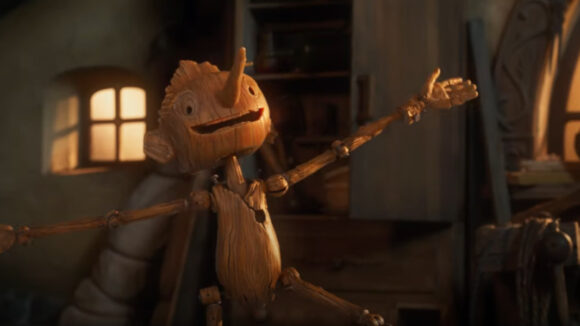Pinnochio coming to life in the movie trailer. | Photo / Netflix
If you’ve been following animated announcements and releases from the past year, you’ll no doubt have realized there have been three different films based on The Adventures of Pinocchio this year.
The first, and most bizarre, was the Russian direct-to-DVD film Pinocchio: The True Story starring Pauly Shore as a very different version of the famous puppet. The second was a live-action remake of Disney’s Pinocchio, directed by Robert Zemeckis, starring Benjamin Evan Ainsworth as Pinocchio and Tom Hanks as Geppetto. However, the third, and our focus today, is Guillermo del Toro’s Pinocchio, another stop-motion film from Netflix, this time helmed by Guillermo del Toro.
After languishing in development purgatory and bouncing between different stars and studios, this take on Pinocchio was released on Netflix on December 9th, 2022.
Del Toro’s take on Carlo Collodi’s classic story occurs primarily during World War II in Mussolini-controlled Italy. After losing his son Carlo in a bombing 20 years prior, a carpenter named Geppetto – played by David Bradley – creates a wooden puppet from a pine tree his son planted. The puppet – played by Gregory Mann – is unexpectedly brought to life by the Blue Sprite – played by Tilda Swinton – and named Pinocchio. Over the next several days, Pinocchio learns valuable lessons about the world around him and receives a wake-up call that things in his home country of Italy may not be as perfect as he perceives.
The most prominent aspect of del Toro’s take on Pinocchio is undeniably the modeling work on display. Considering the puppets and models were created by The Jim Henson Company in collaboration with ShadowMachine, it’s little wonder why these puppets are intricately detailed and textured. Every character moves with a certain blend between realism and cartoonish exaggeration, which aids the movie’s tone and the characterization of its cast well. The scenes the characters occupy feel lived in yet still alive, with gorgeous backdrops behind them and details that make each scene pop. Special mention goes to the scenes taking place in the afterlife. Everything there glows with this fantastic surrealism that helps them stand out from the rest of the film. This mixture of different imageries lends the film the tone of a very grim storybook, which I feel helps the film stand out from the other adaptations.
Speaking of the film’s tone, that was one of the most striking elements. Whereas the other two Pinocchio adaptations played fairly close to the original story’s tone, del Toro’s take delved right into the heart of Mussolini-controlled Italy during World War II. Pinocchio’s appropriately childlike outlook on the world doesn’t do said tone a disservice, and it helps enhance the film. It creates this perfectly bittersweet atmosphere that hangs over the movie and drives many conflicts between Pinocchio and those he encounters. When the film does take direct jabs at Mussolini and his regime, it does so in a way that reflects reactions to him at the time and feels very natural. The tone could appeal to a wide range of demographics with its display of childhood fantasy and grim realities of a bygone era.
All of the wonderful imagery on display here would not be as beautiful as it was without the film’s strikingly original compositions. Much like the tone, the score by Academy Award-winning composer Alexandre Desplat strikes that perfect balance between whimsy and wartime. Despite how lighthearted they may be, the pieces all have a feeling of dread, which suits the film perfectly. The original songs performed by the cast are also excellent, with Pinocchio’s “Ciao Papa” being one of the standouts due to how well it solidifies his worldview. In addition, every audio element of this movie enhances the visuals in a distinct way that only heightens the film’s powerful messages through its lyrics and instrumentation.
Overall, Guillermo del Toro’s Pinocchio is, in my opinion, one of the most striking recent animated films in terms of visuals and tone. Del Toro has stated he firmly believes “animation is cinema,” and this is a step in the right direction. Animation matters and the work of del Toro’s team shows why it does – it can take a story told a dozen times over and make it feel special. This adaptation gets a positively glowing 10/10 and a strong recommendation in addition. I thoroughly support this piece of work and eagerly anticipate whatever comes after.
Guillermo del Toro’s Pinocchio is currently streaming exclusively on Netflix.


